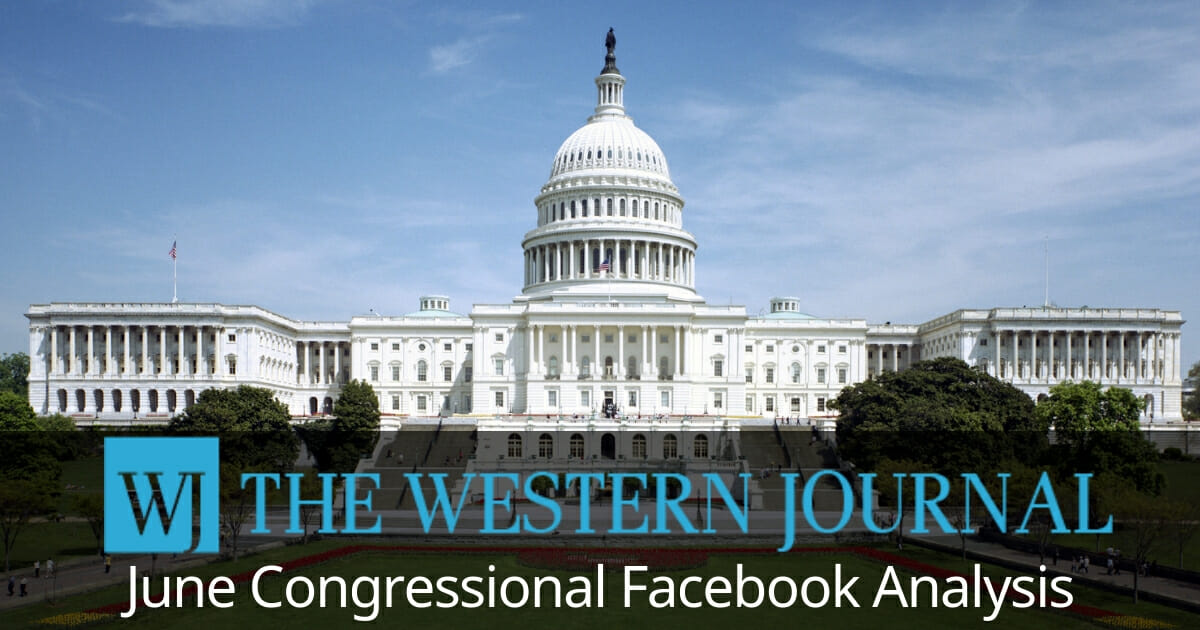
By the Numbers: Here's How Members of Congress Did on Facebook in June
Engagement on Facebook pages associated with members of both mainline political parties has continued to fluctuate in the year following the social media giant’s major algorithm changes in 2018, according to a continued analysis by The Western Journal.
The year 2018 was full of challenges for the social media giant. Lawmakers and politicians have repeatedly questioned the credibility of Facebook’s claims of being an unbiased platform.
Facebook also experienced a series of data breaches that brought security and privacy to the forefront of concerns about social media.
In a November 2018 article for The Epoch Times, Robert Epstein outlined how big tech companies like Facebook can shift votes in elections.
“Facebook can affect election outcomes in at least five different ways: by biasing its trending box, biasing its center newsfeed, encouraging people to look for election-related material in its search bar, sending out targeted register-to-vote reminders, and sending out targeted go-out-and-vote reminders,” he wrote.
Recent statistics show Facebook’s dominance in the United States. As of April 2019, there were 190 million Facebook users in the U.S. That’s more than half of our country’s total population.
Big tech companies deny that their algorithms can be tweaked to meddle in elections, but the effects of the algorithm changes can be seen in the numbers.
According to The Western Journal’s ongoing analysis of more recent data, pages associated with members of both major political parties saw a significant decrease in interactions with readers following the change in January 2018.
Analysis of data from June 2019 shows that there still seems to be a disparity in interaction rate on Republican and Democratic congressional Facebook pages, but the interaction rate follows the same general trend throughout the month.
The Numbers
The Western Journal recently analyzed the interaction rates on congressional Facebook pages from June 2019.
Interaction rates are the average interactions (likes, shares or comments on a post) divided by the number of page followers for each page. Regardless of a change in the number of posts or followers, the interaction rate on a given Facebook page should remain similar from month to month, all else being equal.
For comparison, a previous analysis had shown pages operated by congressional Democrats had an average interaction rate of 0.59 percent for the month of May, whereas pages run by their Republican counterparts saw an average interaction rate of 0.45 percent.
Speaking generally, interaction rates for both Democrat and Republican congressional pages seemed to be fairly even throughout the month of June with Democratic pages trending up and Republican pages trending down at the end of the month.
In the first full week of June (June 2 – June 8), Democratic pages had a 0.61 percent interaction rate, while Republican pages had a 0.54 percent interaction rate.
During the week of June 9 – June 15, there was a 0.68 percent interaction rate on Democratic pages and a 0.54 percent interaction rate on Republican pages.
From June 16 – June 22, Democratic pages had a 0.65 percent interaction rate compared with a 0.52 percent interaction rate on Republican pages.
In the last full week of June (June 23 – June 29), Democratic pages had a 0.68 percent interaction rate, while there was a 0.51 percent interaction rate on Republican pages.
June was a fairly busy month both nationally and internationally.
During a three-day diplomatic state visit to the United Kingdom, President Donald Trump met with Queen Elizabeth II on June 3.
“The Queen gave Donald Trump an abridged first edition of Winston Churchill’s book, ‘The Second World War,’” CNN reported. “The book, printed in 1959, is presented in a crimson and gold-tooled cover. It features a gold royal cypher, silk endpapers and hand-sewn headbands in the colors of the US flag.”
On June 7, Mexico City and the Trump administration reached an immigration deal to avoid the U.S. imposing a 5 percent tariff on all of Mexico’s goods. In exchange, the Mexican government promised to create new measures to reduce illegal immigration.
Trump tweeted on June 13 that White House press secretary Sarah Sanders would be leaving the White House at the end of the month.
After 3 1/2 years, our wonderful Sarah Huckabee Sanders will be leaving the White House at the end of the month and going home to the Great State of Arkansas….
— Donald J. Trump (@realDonaldTrump) June 13, 2019
During an event that evening, Sanders thanked the president for the chance to serve.
“This has been the honor of a lifetime,” she said. “I couldn’t be prouder to have the opportunity to serve my country, particularly to work for this president. He has accomplished so much in these last two-and-a-half years.”
“I’ve loved every minute, even the hard minutes,” she added. “I love the president.”
On June 20, the U.S. military announced that a Navy high-altitude drone was shot down over the Persian Gulf region by an Iranian surface-to-air missile.
Capt. Bill Urban, a U.S. Central Command spokesman, said in a statement that reports coming from Iran that claim the drone was flying over the Islamic Republic are absolutely “false.”
“This was an unprovoked attack on a U.S. surveillance asset in international airspace,” the statement said.
The first 2020 Democratic presidential debates happened June 26 and June 27, with half of the candidates speaking on one night and the other half on the second night.
One of the biggest stories to come out of the debates was Sen. Kamala Harris’ takedown of former Vice President Joe Biden.
“I will direct this at Vice President Biden,” Harris said, as the Washington Examiner reported. “I do not believe you are a racist and I agree with you when you commit yourself to the importance of finding common ground.
“But I also believe and it’s personal and it was hurtful to hear you talk about the reputations of two United States senators who built their reputations and career on the segregation of race in this country,” she added.
Trump made history on June 30 when he set foot in North Korea and became the first sitting U.S. president to do so.
The largely theatrical move was meant to signal that the two countries have once again agreed to start nuclear negotiations, Politico reported.
In the House of Representatives, there was a 0.76 percent interaction rate on Democratic pages and a 0.91 percent interaction rate on Republican pages during the week of June 2 – June 8.
Interaction rates during the week of June 9 – June 15 were at 0.79 percent for Democratic pages and 0.93 percent for Republican pages.
During the week of June 16 – June 22, there was a 0.79 percent interaction rate on Democratic pages and 0.89 percent on Republican pages.
In the last full week of June (June 23 – June 29), Democratic pages had a 0.75 percent interaction rate compared to a 0.85 percent interaction rate on Republican pages.
In the Senate, there was a 0.45 percent interaction rate on Democratic pages and a 0.16 percent interaction rate on Republican pages during the week of June 2 – June 8.
Interaction rates during the week of June 9 – June 15 were at 0.57 percent for Democratic pages and 0.14 percent for Republican pages.
During the week of June 16 – June 22, there was a 0.51 percent interaction rate on Democratic pages and a 0.14 percent interaction rate on Republican pages.
In the last full week of June (June 23 – June 29), Democratic pages had a 0.61 percent interaction rate compared to a 0.16 percent interaction rate on Republican pages.
Why This Matters
In January 2018, Facebook CEO Mark Zuckerberg announced that the social media platform would be rolling out a new algorithm. This algorithm would prioritize “friends, family and groups” in users’ News Feeds and show less public content, such as posts from “businesses, brands and media.” The decrease in interaction rates on these representatives’ pages indicates that some pages have indeed been unevenly impacted, intentionally or unintentionally, since this change was made.
This change continues to have serious implications for the future.
According to a July 2018 analysis by The Western Journal, Facebook pages associated with members of Congress from both major parties saw a significant decrease in interactions with readers in the months immediately following that algorithm change. However, the Facebook pages of Republican members of the House and Senate were affected more than those of their Democratic counterparts.
This means that Americans who stay informed about their elected representatives by following the Facebook pages of their state’s senators and representatives are less likely to see posts from these pages.
Additionally, if representatives are hindered in their ability to deliver their stance on issues to the people they represent, the public is less likely to know where they stand on the issues — leading to an uninformed public, which could swing elections.
It could be argued that the closing of the gap in interaction rates between Republican and Democratic politicians follows a closing of the “enthusiasm gap” between Republican and Democratic voters.
Where the Data Comes From
To conduct this evaluation, The Western Journal extracted Facebook data from CrowdTangle for all current members of Congress with an official Facebook page, using CrowdTangle’s lists: U.S. House Democrats, U.S. Senate Democrats, U.S. House GOP and U.S. Senate GOP.
The Western Journal also used CrowdTangle’s calculation of each chamber of Congress’ weekly interaction rate. Those weekly interaction rates were then combined by taking the average of the two to find the interaction rate for Republican and Democratic congressional Facebook pages.
This data measures users’ interactions with the posts and not the reach of the post. Reach data is available only to individual publishers and is not made public by Facebook. However, the interactions are good general indicators of reach because when more users see a given post, interactions with that post should rise accordingly.
The fact that Facebook only reveals a limited amount of data regarding public pages — and essentially no data at all about the algorithm used to show posts on users’ News Feeds — in turn limits the ability of users, journalists and others to analyze cause and effect.
Facebook’s significant lack of data transparency makes it impossible for The Western Journal, government regulators or anyone else to defend Facebook’s internal processes as unbiased, make a credible accusation of intentional bias or make any sort of defensible statement in between.
Therefore, The Western Journal has analyzed the data available to us in this analysis as well as others.
Benjamin Murray contributed to data compilation and charts for this story.
Truth and Accuracy
We are committed to truth and accuracy in all of our journalism. Read our editorial standards.
Advertise with The Western Journal and reach millions of highly engaged readers, while supporting our work. Advertise Today.












